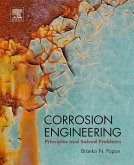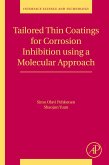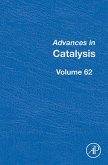Iron Ore (eBook, ePUB)
Mineralogy, Processing and Environmental Sustainability
Redaktion: Lu, Liming


Alle Infos zum eBook verschenken

Iron Ore (eBook, ePUB)
Mineralogy, Processing and Environmental Sustainability
Redaktion: Lu, Liming
- Format: ePub
- Merkliste
- Auf die Merkliste
- Bewerten Bewerten
- Teilen
- Produkt teilen
- Produkterinnerung
- Produkterinnerung

Hier können Sie sich einloggen

Bitte loggen Sie sich zunächst in Ihr Kundenkonto ein oder registrieren Sie sich bei bücher.de, um das eBook-Abo tolino select nutzen zu können.
Iron Ore: Mineralogy, Processing and Environmental Issues summarizes recent, key research on the characterization of iron ores, including important topics such as beneficiation (separation and refining), agglomeration (e.g., production of pellets or powders), blast furnace technology for smelting, and environmental issues relating to its production. The text is an ideal reference on the topic during a time when iron ore production has increased significantly, driven by increasing demand from countries such as India and China. - Provides a comprehensive overview of the global iron ore industry,…mehr
- Geräte: eReader
- ohne Kopierschutz
- eBook Hilfe
![Iron Ore (eBook, ePUB) Iron Ore (eBook, ePUB)]() Iron Ore (eBook, ePUB)233,95 €
Iron Ore (eBook, ePUB)233,95 €![Corrosion Engineering (eBook, ePUB) Corrosion Engineering (eBook, ePUB)]() Branko N. PopovCorrosion Engineering (eBook, ePUB)104,95 €
Branko N. PopovCorrosion Engineering (eBook, ePUB)104,95 €![Tailored Thin Coatings for Corrosion Inhibition Using a Molecular Approach (eBook, ePUB) Tailored Thin Coatings for Corrosion Inhibition Using a Molecular Approach (eBook, ePUB)]() Simo Olavi PehkonenTailored Thin Coatings for Corrosion Inhibition Using a Molecular Approach (eBook, ePUB)138,95 €
Simo Olavi PehkonenTailored Thin Coatings for Corrosion Inhibition Using a Molecular Approach (eBook, ePUB)138,95 €![Fundamentals and Applications of Nano Silicon in Plasmonics and Fullerines (eBook, ePUB) Fundamentals and Applications of Nano Silicon in Plasmonics and Fullerines (eBook, ePUB)]() Munir H. NayfehFundamentals and Applications of Nano Silicon in Plasmonics and Fullerines (eBook, ePUB)127,95 €
Munir H. NayfehFundamentals and Applications of Nano Silicon in Plasmonics and Fullerines (eBook, ePUB)127,95 €![Advances in Catalysis (eBook, ePUB) Advances in Catalysis (eBook, ePUB)]() Advances in Catalysis (eBook, ePUB)149,95 €
Advances in Catalysis (eBook, ePUB)149,95 €![Biopolymer Electrolytes (eBook, ePUB) Biopolymer Electrolytes (eBook, ePUB)]() Sudhakar Y NBiopolymer Electrolytes (eBook, ePUB)76,95 €
Sudhakar Y NBiopolymer Electrolytes (eBook, ePUB)76,95 €![Phase Diagrams and Thermodynamic Modeling of Solutions (eBook, ePUB) Phase Diagrams and Thermodynamic Modeling of Solutions (eBook, ePUB)]() Arthur D. PeltonPhase Diagrams and Thermodynamic Modeling of Solutions (eBook, ePUB)104,95 €
Arthur D. PeltonPhase Diagrams and Thermodynamic Modeling of Solutions (eBook, ePUB)104,95 €-
-
-
Dieser Download kann aus rechtlichen Gründen nur mit Rechnungsadresse in A, B, BG, CY, CZ, D, DK, EW, E, FIN, F, GR, HR, H, IRL, I, LT, L, LR, M, NL, PL, P, R, S, SLO, SK ausgeliefert werden.
- Produktdetails
- Verlag: Elsevier Science & Techn.
- Seitenzahl: 666
- Erscheinungstermin: 24. Juli 2015
- Englisch
- ISBN-13: 9781782421597
- Artikelnr.: 43816958
- Verlag: Elsevier Science & Techn.
- Seitenzahl: 666
- Erscheinungstermin: 24. Juli 2015
- Englisch
- ISBN-13: 9781782421597
- Artikelnr.: 43816958
- Herstellerkennzeichnung Die Herstellerinformationen sind derzeit nicht verfügbar.
- List of Contributors
- Preface
- 1: Introduction: overview of the global iron ore industry
- Abstract
- 1.1 Introduction
- 1.2 Iron ore mining operations by country
- 1.3 Technology status and challenges
- 1.4 Iron ore outlook
- Part One: Characterization and analysis of iron ore
- 2: Mineralogical, chemical, and physical characteristics of iron ore
- Abstract
- 2.1 Introduction
- 2.2 Mineralogy
- 2.3 Chemical composition
- 2.4 Physical properties
- 2.5 Future trends
- 3: XRD analysis and evaluation of iron ores and sinters
- Abstract
- 3.1 Introduction
- 3.2 Principles of powder X-ray diffraction
- 3.3 Rietveld analysis
- 3.4 Sources of error in XRD analysis
- 3.5 Applications of cluster analysis
- 3.6 Applicability of XRD analysis
- 3.7 Use of mass balancing in iron ore analysis
- 3.8 The principal minerals and phases
- 3.9 XRD for the characterization of Iron ores
- 3.10 XRD in sintering and pelletizing
- 3.11 Summary and conclusions
- 4: Automated optical image analysis of natural and sintered iron ore
- Abstract
- 4.1 Introduction: Overview of optical image analysis technique
- 4.2 Mineralogical characteristics of iron ore and sinter
- 4.3 Automated optical image analysis (OIA)
- 4.4 Application of automated OIA to natural and sintered iron ore
- 5: Quantitative analysis of iron ore using SEM-based technologies
- Abstract
- 5.1 Introduction
- 5.2 Principles of SEM-based technologies
- 5.3 Application of automated SEM-based technologies to ore characterization
- 5.4 Characterization of natural and sintered iron ore using QEMSCAN
- 5.5 Summary
- 5.6 Future trends
- 6: Characterization of iron ore by visible and infrared reflectance and, Raman spectroscopies
- Abstract
- 6.1 Introduction
- 6.2 Principles of reflectance and Raman spectroscopies
- 6.3 Technologies
- 6.4 Reflectance and Raman spectroscopies of iron ore minerals
- 6.5 Future trends
- 2: Mineralogical, chemical, and physical characteristics of iron ore
- Part Two: Extraction, comminution, separation, and beneficiation of iron ore
- 7: Iron ore extraction techniques
- Abstract
- 7.1 Introduction
- 7.2 Iron ore mining-an historical UK context
- 7.3 Underground iron ore mining: Kiruna, Sweden
- 7.4 Modern-day surface mining: the Pilbara deposit
- 7.5 Modern day surface mining: iron ore in Minas Gerais Province, Brazil
- 7.6 Conclusions
- 8: Developments in iron ore comminution and classification technologies
- Abstract
- 8.1 Introduction
- 8.2 Iron ore crushing and screening
- 8.3 Iron ore grinding and classification
- 8.4 Future trends in iron ore comminution and classification
- 9: Developments in the physical separation of iron ore: magnetic separation
- Abstract
- 9.1 Introduction
- 9.2 Principle of magnetic separation
- 9.3 Magnetic separators
- 9.4 Typical flow sheets for iron ore separation
- 9.5 Challenges and recent advances in magnetic separation
- 9.6 Summary
- 10: Developments in nonmagnetic physical separation technologies for hematitic/goethitic iron ore
- Abstract
- 10.1 Physical processing for enhanced chemical and/or physical properties
- 10.2 Dense medium separation
- 10.3 Jigging
- 10.4 Upflow classification
- 10.5 Spiraling for iron ore beneficiation
- 11: Developments in the physiochemical separation of iron ore
- Abstract
- 11.1 Introduction
- 11.2 Mineral properties
- 11.3 Iron ore flotation
- 11.4 K
- 7: Iron ore extraction techniques
- List of Contributors
- Preface
- 1: Introduction: overview of the global iron ore industry
- Abstract
- 1.1 Introduction
- 1.2 Iron ore mining operations by country
- 1.3 Technology status and challenges
- 1.4 Iron ore outlook
- Part One: Characterization and analysis of iron ore
- 2: Mineralogical, chemical, and physical characteristics of iron ore
- Abstract
- 2.1 Introduction
- 2.2 Mineralogy
- 2.3 Chemical composition
- 2.4 Physical properties
- 2.5 Future trends
- 3: XRD analysis and evaluation of iron ores and sinters
- Abstract
- 3.1 Introduction
- 3.2 Principles of powder X-ray diffraction
- 3.3 Rietveld analysis
- 3.4 Sources of error in XRD analysis
- 3.5 Applications of cluster analysis
- 3.6 Applicability of XRD analysis
- 3.7 Use of mass balancing in iron ore analysis
- 3.8 The principal minerals and phases
- 3.9 XRD for the characterization of Iron ores
- 3.10 XRD in sintering and pelletizing
- 3.11 Summary and conclusions
- 4: Automated optical image analysis of natural and sintered iron ore
- Abstract
- 4.1 Introduction: Overview of optical image analysis technique
- 4.2 Mineralogical characteristics of iron ore and sinter
- 4.3 Automated optical image analysis (OIA)
- 4.4 Application of automated OIA to natural and sintered iron ore
- 5: Quantitative analysis of iron ore using SEM-based technologies
- Abstract
- 5.1 Introduction
- 5.2 Principles of SEM-based technologies
- 5.3 Application of automated SEM-based technologies to ore characterization
- 5.4 Characterization of natural and sintered iron ore using QEMSCAN
- 5.5 Summary
- 5.6 Future trends
- 6: Characterization of iron ore by visible and infrared reflectance and, Raman spectroscopies
- Abstract
- 6.1 Introduction
- 6.2 Principles of reflectance and Raman spectroscopies
- 6.3 Technologies
- 6.4 Reflectance and Raman spectroscopies of iron ore minerals
- 6.5 Future trends
- 2: Mineralogical, chemical, and physical characteristics of iron ore
- Part Two: Extraction, comminution, separation, and beneficiation of iron ore
- 7: Iron ore extraction techniques
- Abstract
- 7.1 Introduction
- 7.2 Iron ore mining-an historical UK context
- 7.3 Underground iron ore mining: Kiruna, Sweden
- 7.4 Modern-day surface mining: the Pilbara deposit
- 7.5 Modern day surface mining: iron ore in Minas Gerais Province, Brazil
- 7.6 Conclusions
- 8: Developments in iron ore comminution and classification technologies
- Abstract
- 8.1 Introduction
- 8.2 Iron ore crushing and screening
- 8.3 Iron ore grinding and classification
- 8.4 Future trends in iron ore comminution and classification
- 9: Developments in the physical separation of iron ore: magnetic separation
- Abstract
- 9.1 Introduction
- 9.2 Principle of magnetic separation
- 9.3 Magnetic separators
- 9.4 Typical flow sheets for iron ore separation
- 9.5 Challenges and recent advances in magnetic separation
- 9.6 Summary
- 10: Developments in nonmagnetic physical separation technologies for hematitic/goethitic iron ore
- Abstract
- 10.1 Physical processing for enhanced chemical and/or physical properties
- 10.2 Dense medium separation
- 10.3 Jigging
- 10.4 Upflow classification
- 10.5 Spiraling for iron ore beneficiation
- 11: Developments in the physiochemical separation of iron ore
- Abstract
- 11.1 Introduction
- 11.2 Mineral properties
- 11.3 Iron ore flotation
- 11.4 K
- 7: Iron ore extraction techniques







